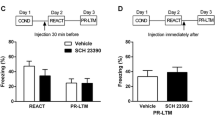Abstract
Rationale and objective
The N-methyl-d-aspartate receptor agonist d-cycloserine (DCS) facilitates extinction following Pavlovian fear conditioning or conditioned place preference in rats, but its effects on extinction following operant conditioning are not previously established. We studied the effects of DCS on operant extinction with mice, previously shown to be facilitated by GABAergic potentiators including chlordiazepoxide.
Materials and methods
Following training of lever pressing by C57Bl/6 male mice on a discrete-trial fixed-ratio food reinforcement schedule with six reinforcers per session, 48-trial extinction sessions were conducted at 3- (Experiment 1) or 4-day intervals (Experiment 2). Effects of DCS (15 or 30 mg/kg, i.p.) administered immediately after 48-trial extinction sessions were compared with those of saline injections.
Results
With 3-day intervals between extinction sessions, post-session administration of DCS facilitated extinction, and this effect was stronger with 4-day intervals between extinction sessions. Facilitation of extinction by post-session drug administration persisted over a number of extinction sessions.
Conclusions
Operant extinction in mice can be facilitated by DCS, a glutamatergic agonist, as well as by GABAergic potentiators. The relationship between glutamatergic and GABAergic processes in operant extinction is yet to be established. These findings strengthen the basis for clinical uses of DCS.


Similar content being viewed by others
References
Botreau F, Paolone G, Stewart J (2006) d-Cycloserine facilitates extinction of a cocaine-induced conditioned place preference. Behav Brain Res 172:173–178
Davis M, Ressler K, Rothbaum BO, Richardson R (2006) Effects of D-cycloserine on extinction: translation from preclinical to clinical work. Biol Psychiatry 60:369–375
Dickinson A (1985) Actions and habits: the development of behavioural autonomy. Phil Trans Roy Soc (London) B308:67–78
Gabriele A, Packard MG (2007) D-Cycloserine enhances memory consolidation of hippocampus-dependent latent extinction. Learn Mem 14:468–471
Harris JA, Westbrook RF (1998) Evidence that GABA transmission mediates context-specific extinction of learned fear. Psychopharmacology 140:105–115
Joel D, Doljansky J (2003) Selective alleviation of compulsive lever-pressing in rats by D-1, but not D-2, blockade: possible implications for the involvement of D-1 receptors in obsessive-compulsive disorder. Neuropsychopharmacology 28:77–85
Ledgerwood L, Richardson R, Cranney J (2003) Effects of D-cycloserine on extinction of conditioned freezing. Behav Neurosci 117:341–349
Leslie JC, Shaw D, McCabe C, Reynolds DS, Dawson GR (2004) Effects of drugs that potentiate GABA on extinction of positively-reinforced operant behaviour. Neurosci Biobehav Rev 28:229–238
Leslie JC, Shaw D, Gregg G, McCormick N, Reynolds DS, Dawson GR (2005) Effects of reinforcement schedule on facilitation of operant extinction by chlordiazepoxide. J Exp Anal Behav 84:327–338
Leslie JC, Sharp K, Quigley L, Carson A, McGovern S, Shaw D (2007) Effects of chlordiazepoxide on extinction of operant behaviour in mice vary with time of administration and rate of extinction. Eur J Behav Anal 8:257–266
McCabe C, Shaw D, Atack JR, Street LJ, Wafford KA, Dawson GR, Reynolds DS, Leslie JC (2004) Subtype-selective GABAergic drugs facilitate extinction of mouse operant behavior. Neuropharmacology 6:1–8
Moody EW, Sunsay C, Bouton ME (2006) Priming and trial spacing in extinction: effects on extinction performance, spontaneous recovery, and reinstatement in appetitive conditioning. Q J Exp Psychol 59:809–829
Myers KM, Davis M (2002) Behavioral and neural analysis of extinction. Neuron 36:567–584
Parnas AS, Weber M, Richardson R (2005) Effects of multiple exposures to D-cycloserine on extinction of conditioned fear in rats. Neurobiol Learn Mem 83:224–231
Pavlov IP (1927) Conditioned reflexes. Oxford University Press, London
Pitman RK (1989) Animal models of compulsive behaviour. Biol Psychiat 26:189–198
Quartermain D, Mower J, Rafferty MF, Herting RL, Lanthorn TH (1994) Acute but not chronic activation of the NMDA-coupled glycine receptor with D-cycloserine facilitates learning and retention. Eur J Pharmacol 257:7–12
Shaw D, Dawson GR, Reynolds DS, McCabe C, Leslie JC (2004) Effects of chlordiazepoxide on extinction and re-acquisition of operant behavior in mice. Behav Pharmacol 15:225–232
Shumyatsky GP, Tsvetkov E, Malleret G, Vronskaya S, Hatton M, Hampton L et al (2002) Identification of a signalling network in lateral nucleus of amygdala important for inhibiting memory specifically related to learned fear. Cell 111:905–918
Stowell JR, Berntson GG, Sarter M (2000) Attenuation of the bidirectional effects of chlordiazepoxide and FG7142 on conditioned response suppression and associated cardiovascular reactivity by loss of cortical cholinergic inputs. Psychopharmacology 150:141–149
Walker DL, Davis M (2002) The role of amygdala glutamate receptors in fear learning, fear-potentiated startle, and extinction. Pharmacol Biochem Behav 71:379–392
Walker DL, Ressler KJ, Lu KT, Davis M (2002) Facilitation of conditioned fear extinction by systemic administration or intra-amygdala infusions of D-cycloserine as assessed with fear-potentiated startle in rats. J Neurosci 22:2343–2351
Williams JH, Gray JA, Sinden J, Buckland C, Rawlins JNP (1990) Effects of GABAergic drugs, fornicotomy, hippocampectomy and septal lesions on the extinction of a discrete-trial fixed ratio 5 lever-press response. Behav Brain Res 41:129–150
Acknowledgements
This research was supported by a grant from the U.K. Biotechnology and Biological Sciences Research Council. Experimental procedures were in accordance with the UK Animals (Scientific Procedures) Act (1986) and its associated guidelines. We are indebted to Michael Begley and Paul Kennedy for assistance in running Experiment 2.
Author information
Authors and Affiliations
Corresponding author
Rights and permissions
About this article
Cite this article
Shaw, D., Norwood, K., Sharp, K. et al. Facilitation of extinction of operant behaviour in mice by d-cycloserine. Psychopharmacology 202, 397–402 (2009). https://doi.org/10.1007/s00213-008-1312-7
Received:
Accepted:
Published:
Issue Date:
DOI: https://doi.org/10.1007/s00213-008-1312-7




